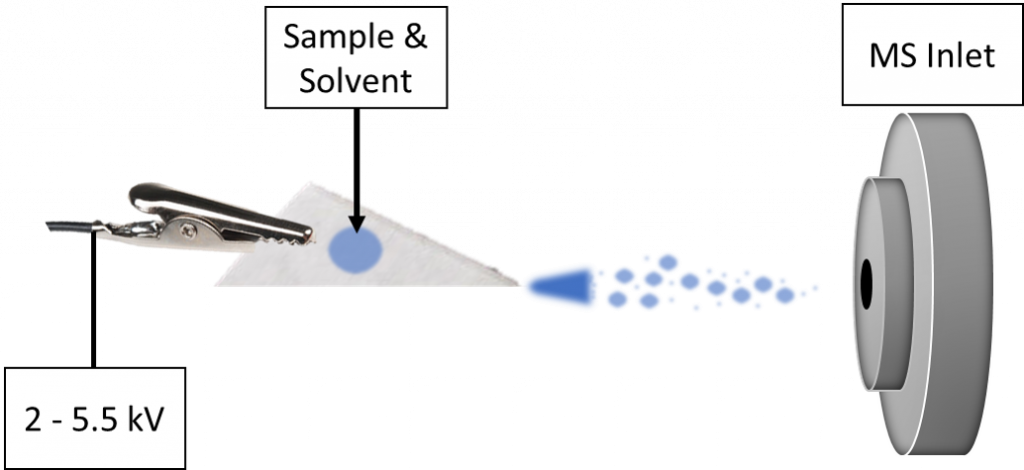8 Explosives Identification
Introduction
Purpose
Identify unknown explosives using mass spectrometry.
Energetic Materials
When discussing the analysis and identification of explosive compounds, this may be in the context of large amounts of material found before they've been used, trace residues in a post-blast setting, or hidden explosives (such as on a person). This week's experiment will focus on methods that will be primarily useful in either bulk sample testing or trace residue testing.
Alternative Mass Spectrometry Sample Introduction Methods
Over the last couple of decades, researchers have developed numerous sample introduction methods for mass spectrometers that are designed to provide fast characterization without chromatography. These new methods are often in the form of new or modified ambient ionization sources. Most of these methods are not commonly adopted into routine workflow for forensic chemistry or toxicology labs for a number of reasons - time to validate when the current methods work, time to rewrite SOPs, need to replace retention time as part of a confirmatory analysis scheme, cost for new equipment, etc.
However, forensic research labs in academic, government, and military organizations frequently investigate these new methods and are always looking for methods that will make detecting illicit substances easier, faster, safer, and/or more sensitive. Sometimes, they're looking to use them in their labs, but they may also be looking to use them in mobile labs, integrate them into compact instrumentation that may be carried, or other innovative methods.
Some of the more popular ambient ionization sources that have sprung up for forensic applications include, among others, nanospray ionization (NSI), desorption electrospray ionization (DESI), direct analysis in real time (DART), and paper spray (PS).
Paper Spray - Mass Spectrometry
Paper spray is an intriguing variation of electrospray ionization that can provide a quick, easy prep analysis of potentially complex samples. To use this technique, a small amount of sample can be added to a triangular piece of paper with an appropriate solvent as shown in Figure 1 below. The paper is then positioned near the mass spectrometer inlet. Voltage can then be applied to one side of the triangle, promoting an electrospray-like phenomenon to occur at the opposite corner of the triangle (the paper spray tip). This method lends itself well to direct analysis of biological samples like blood and urine and is capable of ng/mL quantitation of some substances in these matrices, but these are by no means the only substances or applications that may benefit. For example, you'll use it in this lab to analyze and quantitate an explosive compound.

Materials and Methods
Supplies
- Internal standard (e.g., caffeine)
- Explosive sample
- Methanol
- Water
- Pipette
- Unknown samples
- LC vials
- PS - MS
Procedure
Prepare Sample
- Add 5 µL of internal standard solution to 1 mL of 50/50 methanol/water in an LC vial
- If explosive sample is a solid:
- Make a 1 mg/mL solution and dilute it 1/100 in an LC vial
- Add 5 µL of internal standard solution to sample solution
- If explosive sample is a liquid:
- Transfer 1 mL to an LC vial
- Add 5 µL of internal standard solution to sample solution
- If explosive sample is trace residue on a solid:
- Use 50/50 methanol water to rinse the residue into a small beaker or other glassware
- Filter any solids out with filter paper or similar
- Dilute more than you think you should at first prior to analysis, then if no signal, adjust dilution ratio
Analysis
- Run a blank first and ensure signal/noise is acceptable
- Run internal standard
- Run sample(s)
- Collect data to generate spectra for each compound
- If available, fragment each compound and collect that data as well
- Note parameters such as PS voltage, mass analysis range, collision energy, etc.
Lab Report
- Generate spectra by plotting raw data in Excel or similar
- Label all major m/z peaks and interpret
- Identify each compound
References
McBride, E. M., Mach, P. M., Dhummakupt, E. S., Dowling, S., Carmany, D. O., Demond, P. S., … Glaros, T. (2019). Paper Spray Ionization: Applications and Perspectives. TrAC Trends in Analytical Chemistry, 118, 722-730. https://doi.org/10.1016/j.trac.2019.06.028
Media Attributions
- Paper spray Ionization © Charlie Williams

